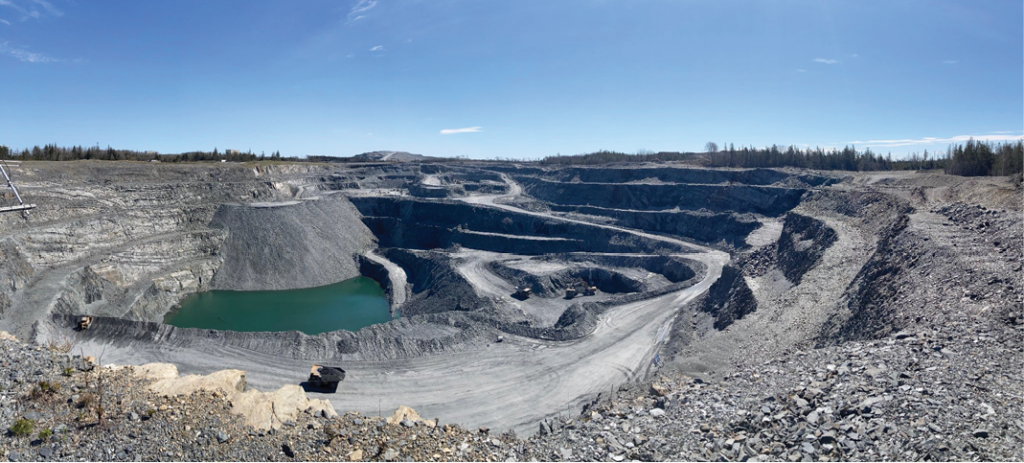
Nova Scotia has a rich history of gold mining dating back to the mid-1800s. Long before the Klondike gold rush of 1897, Nova Scotia experienced its first gold rush in the Mooseland area in 1860. In the following few years, a large area, now called the gold district of Nova Scotia, witnessed many gold discoveries. The area covers most of the shoreline of the province along the Atlantic Ocean including the counties of Guysborough, Halifax, Lunenburg, and Queens.
Nova Scotia’s natural formations of gold are the result of millions of years of geological processes, including metamorphism, erosion, and chemical reactions. These formations include quartz veins, placer deposits, and sulphide-associated gold deposits. New exploration techniques, such as geochemical and geophysical surveys, are helping to identify new gold deposits in the province. As these techniques evolve, more natural formations of gold will be discovered in Nova Scotia, providing new opportunities for the province’s mining industry.


Currently, Northern Shield Resources is exploring between New Glasgow and Antigonish, Transition Metals is targeting areas in the Cape Breton Highlands, Osprey Gold is exploring in several areas including the historic Goldenville site, MegumaGold is hoping to find gold in various areas surrounding other companies’ claims, and SLAM Exploration is planning to drill in Mount Uniacke.
The mining and quarrying industries employ more than 5,000 Nova Scotians, with average annual wages of $55,000, according to the Mining Association of Nova Scotia.
So, what is the current state of gold mining in Nova Scotia?
Atlantic Gold/Moose River consolidated
Currently, the province has one operating gold mine: The Touquoy mine in Moose River, near Middle Musquodoboit, which opened in 2017. According to the company, the mine produced 50,567 oz. of gold in 2022, Table 2 lists the Atlantic operation annual production since 2017. Australian miner St Barbara acquired the mine in 2019 for $722 million.
Four other gold mines are in the environmental assessment stage, including three proposed by St Barbara subsidiary, Atlantic Mining Nova Scotia: Beaver Dam, Cochrane Hill, and Fifteen Mile Stream, and the fourth is Anaconda Mining’s proposed Goldboro mine.
St Barbara is currently exploring prospects along the Moose River Corridor and the south-west region of Nova Scotia, with the aim of extending existing planned pits and potential satellite pits. St Barbara has 21 exploration projects in Nova Scotia and more than 1,900 km2 of exploration. Key exploration targets are near existing deposits, with a focus on targets along strike between Touquoy and Fifteen Mile Stream.
The Fifteen Mile Stream project is located approximately 40 km east-northeast of the Touquoy mine, while the company’s Beaver Dam project is mid-way between the Fifteen Mile Stream project and the Touquoy mine. St Barbara recently updated it Fifteen Mile Stream project. The project redesign now includes a standalone 1.7 million to 1.8 million t/y processing facility, with the Touquoy processing plant being relocated to Fifteen Mile Stream. An update of the project to prefeasibility study level is due in November 2023.
The project targets a 10-year mine life and an average gold production of 60,000 oz. per year. The company now says the relocation of the bulk of the Touquoy processing plant to Fifteen Mile Stream is the preferred development pathway for the next phase of its Atlantic operations.

St Barbara managing director and CEO, Andrew Strelein, said, “This new design for Fifteen Mile Stream is an excellent alternative pathway to development with improved recoveries and with lower overall capital cost and execution risk. It is time to move on from the earlier design with integration with Touquoy given the delays in approvals to our in-pit tailings proposal.” Strelein added that the project redesign represents a simple solution for bringing Fifteen Mile Stream into production.
The Touquoy processing plant, finished in 2017, has a throughput rate of 2.0 million tonnes per year. Although Fifteen Mile Stream ores are expected to be harder and require finer product size compared to the ore from Touquoy mine, the company says the processing plant can handle it. Consequently, reusing Touquoy plant equipment will make the project less expensive.
Social responsibility
In December 2021, St Barbara and the Mooseland and Area Community Association (MACA) signed a community partnership agreement (CPA) that formalizes the company’s commitment to the local community near its Touquoy gold mine.
The agreement aims to help Mooseland members thrive and achieve sustainable benefits and outcomes. It pledged an initial financial contribution of $75,000 plus an annual contribution of $25,000 to the MACA. The agreement runs for three years and any additional years that St Barbara uses Mooseland road for mining operations. The funding was to be used by MACA for community health, environmental management, economic development, and youth education. Subsequently,
St Barbara has also signed CPAs with the food bank and family resource centre closest to the Touquoy Mine.
In 2020, more than 300 people were employed full-time at the Touquoy gold mine in addition to the full-time contractors.
The company said its operation at Touquoy and exploration work at other sites in the province have generated a total of about 350 jobs. According to the province, the company has also spent $25.5 million on local supplies and $10 million on local contractors.
The Touquoy operations have been processing solely from stockpiles since early February; however, the inability to obtain permits for in-pit tailings deposition within a reasonable time will result in the operations moving to care and maintenance by the end of September 2023. Approximately 150 employees who are in roles that will not be required in care and maintenance have been notified and will be provided with appropriate assistance with this transition.



